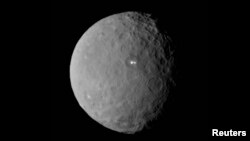NASA's Dawn spacecraft has begun orbiting the dwarf planet Ceres in the asteroid belt between Mars and Jupiter.
The space agency confirmed Friday that Dawn, the first to achieve orbit around a dwarf planet, was captured by the planet's gravity at 1239 UTC, about 61,000 kilometers from Ceres’ surface.
Almost an hour later, mission controllers at NASA’s Jet Propulsion Laboratory received a signal from Dawn that it was "healthy and thrusting with its ion engine," indicating the spacecraft had entered orbit as planned, the agency said in a statement.
"After a journey of 4.9 billion kilometers and seven-and-a-half years, Dawn calls Ceres, home," said Marc Rayman, Dawn chief engineer and mission director at JPL in Pasadena, California. "Since its discovery in 1801, Ceres was known as a planet, then an asteroid and later a dwarf planet," he said.
NASA says in the most recent images taken by Dawn on March 1, Ceres appears as a crescent, due to the position of the spacecraft on a side of the planet away from the sun. When Dawn emerges from Ceres' dark side, expected by mid-April, NASA scientists believe it will send sharper images as it moves to lower orbits around the planet.
According to the agency, Dawn's mission is managed by JPL for NASA's Science Mission Directorate in Washington, but it is a joint project of the United States in partnership with Germany and Italy.
Some information for this report comes from AP, AFP and Reuters.








